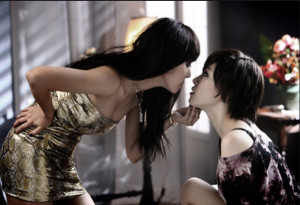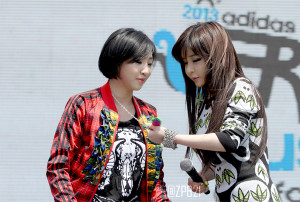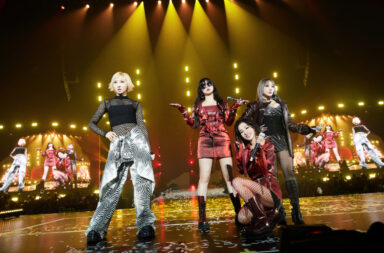 Yulsic. Chaemin. Sulber. Jiafei. Narin. Do these popular pairing names of members from SNSD, 2NE1, f(x), Miss A, and Brown Eyed Girls sound familiar or are they totally new to you? For the record, these ship names refer to different femslash pairings in K-pop. Femslash, also called femmeslash or yuri, is a fan practice where fans explore the relationship between two females, sometimes through a homosexual or lesbian lens. It’s often portrayed as male slash’s less popular and less discussed counterpart. In K-pop, femslash intersects with real person fanfiction (RPF) and real person shipping, since idols portray a certain version of themselves to the public.
Yulsic. Chaemin. Sulber. Jiafei. Narin. Do these popular pairing names of members from SNSD, 2NE1, f(x), Miss A, and Brown Eyed Girls sound familiar or are they totally new to you? For the record, these ship names refer to different femslash pairings in K-pop. Femslash, also called femmeslash or yuri, is a fan practice where fans explore the relationship between two females, sometimes through a homosexual or lesbian lens. It’s often portrayed as male slash’s less popular and less discussed counterpart. In K-pop, femslash intersects with real person fanfiction (RPF) and real person shipping, since idols portray a certain version of themselves to the public.
Leaving value judgements on these fan actions aside for a moment, and rather than debating, dismissing or praising the existence of slash without even discussing femslash in K-pop, let’s take a look at other less asked but important questions: What does K-pop femslash offer its fans that makes it so popular? How do participation and fanworks differ from the more widespread male slash fandoms?
First of all, K-pop femslash doesn’t exactly come out of nowhere. K-pop’s gendered divide between boy groups and girl groups provides the ideal basis for slash RPF of the male and female varieties. High-profile interactions between females are incredibly rare in popular media, which usually frame female interactions as bitchy or competitive–this definitely occurs within K-pop, it’s true. But the fact remains that in K-pop, due to the high number of girl groups, young women interact a ton with other young women: in MVs, variety shows, reality shows, awards shows, and in everyday life, since group members usually live together.
SNSD’s reality series Hello Baby is a great example of why K-pop is the perfect arena for femslash fans. How often do we see nine females as the main cast of a K-drama, TV show or film? How often do we see groups of females getting along, working hard together and performing friendship instead of competition? There are distinct examples of female fanservice with a queer bent to it as well: Who could forget Narsha and Ga-in‘s near-kiss at the end of Brown Eyed Girls’ “Abracadabra” or Miss A’s sexualized physical contact in “Hush”? With so many distinct female personalities and female friendships prettily packaged for mass consumption, it’s only natural that many fans gravitate towards creating fanworks primarily about women.
 This leads to one of two important points: femslash is a predominately female space. K-pop femslash is primarily females writing about female-female friendships and female-female relationships, which can be about but are not limited to romantic or sexual relationships. Fans might write about Bomzy (2NE1’s Park Bom and Minzy) because they find their friendship adorable, intriguing, hot, inspiring, or something else entirely. Female fans create thousands of words of fiction, hours and hours worth of fanvideo and picture edits, and let’s not forget the myriad world of gifs. This is a lot of work! It’s worth noting there are also non-females who participate, but we must realize that the femslash fanspace, particularly when looking at fanfiction, is produced by a female majority and for a female majority. These hours of work come from and lead back to a place where female voices speak and are listened to in return, which I find extremely heartening.
This leads to one of two important points: femslash is a predominately female space. K-pop femslash is primarily females writing about female-female friendships and female-female relationships, which can be about but are not limited to romantic or sexual relationships. Fans might write about Bomzy (2NE1’s Park Bom and Minzy) because they find their friendship adorable, intriguing, hot, inspiring, or something else entirely. Female fans create thousands of words of fiction, hours and hours worth of fanvideo and picture edits, and let’s not forget the myriad world of gifs. This is a lot of work! It’s worth noting there are also non-females who participate, but we must realize that the femslash fanspace, particularly when looking at fanfiction, is produced by a female majority and for a female majority. These hours of work come from and lead back to a place where female voices speak and are listened to in return, which I find extremely heartening.
Not only do fans of femslash create a female space, it is often a queer female space. We broke down two common misconceptions already, that girl group fanfiction is not always romantic or sexual, and that not all femslash fans are lesbians. But consider that a lot of femslash fanfiction is romantic, and some female fans of girl groups are queer, like myself. The femslash community offers a relatively safe place for queer female fans to interact with each other and mobilize around queer female relationships, which happen to be about female K-pop idols. There are entire Livejournal communities, for example, dedicated to each possible pairing of SNSD members (for the record, with the nine members there are thirty possible pairings. Thirty!). Within these spaces, lesbian relationships are often widely discussed, written about, and accepted as normal, and rightfully so.
This is why the common dismissal or demonization of slash fanfiction is unacceptable: sometimes femslash is not even acknowledged as a huge ongoing phenomenon of its own. In addition, just as female idols are judged much more harshly than male idols, female fans are usually judged more harshly than male fans. When slash fans are called delusional or dangerous without nuancing their participation and labor, it feels like another devaluation of females in general. We have to start talking about the context that femslash develops in and the reasons why it is important to so many female and queer female fans. K-pop femslash fanfiction may begin in a version of highly mediated reality, but the space that it creates should be treated as so much more than a simple fantasy.
(Images via Mozzi, Twitter @ZPB21, YouTube [1])


